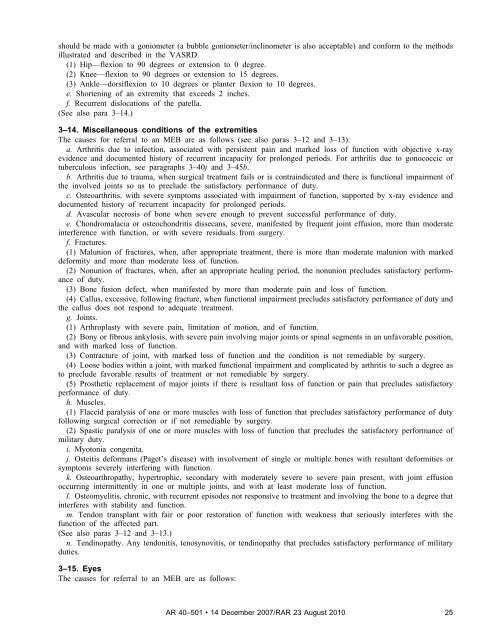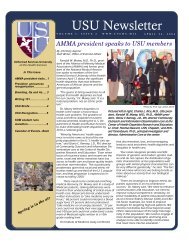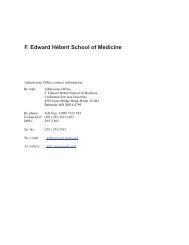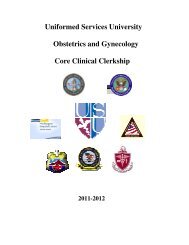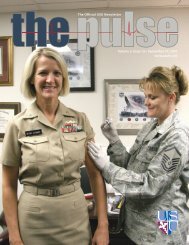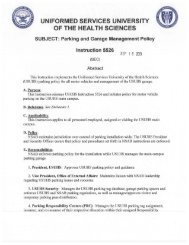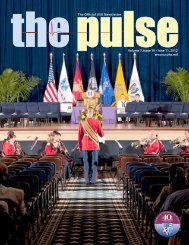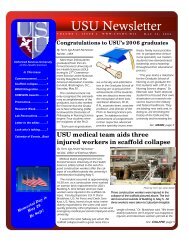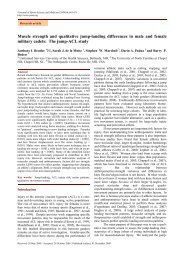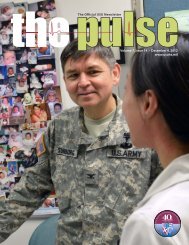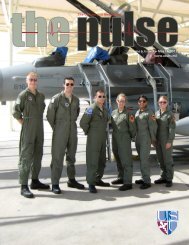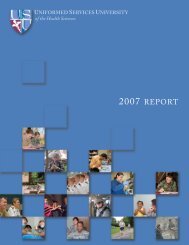should be made with a goniometer (a bubble goniometer/inclinometer is also acceptable) and conform to the methodsillustrated and described in the VASRD.(1) Hip—flexion to 90 degrees or extension to 0 degree.(2) Knee—flexion to 90 degrees or extension to 15 degrees.(3) Ankle—dorsiflexion to 10 degrees or planter flexion to 10 degrees.e. Shortening of an extremity that exceeds 2 inches.f. Recurrent dislocations of the patella.(See also para 3–14.)3–14. Miscellaneous conditions of the extremitiesThe causes for referral to an MEB are as follows (see also paras 3–12 and 3–13):a. Arthritis due to infection, associated with persistent pain and marked loss of function with objective x-rayevidence and documented history of recurrent incapacity for prolonged periods. For arthritis due to gonococcic ortuberculous infection, see paragraphs 3–<strong>40</strong>j and 3–45b.b. Arthritis due to trauma, when surgical treatment fails or is contraindicated and there is functional impairment ofthe involved joints so as to preclude the satisfactory performance of duty.c. Osteoarthritis, with severe symptoms associated with impairment of function, supported by x-ray evidence anddocumented history of recurrent incapacity for prolonged periods.d. Avascular necrosis of bone when severe enough to prevent successful performance of duty.e. Chondromalacia or osteochondritis dissecans, severe, manifested by frequent joint effusion, more than moderateinterference with function, or with severe residuals from surgery.f. Fractures.(1) Malunion of fractures, when, after appropriate treatment, there is more than moderate malunion with markeddeformity and more than moderate loss of function.(2) Nonunion of fractures, when, after an appropriate healing period, the nonunion precludes satisfactory performanceof duty.(3) Bone fusion defect, when manifested by more than moderate pain and loss of function.(4) Callus, excessive, following fracture, when functional impairment precludes satisfactory performance of duty andthe callus does not respond to adequate treatment.g. Joints.(1) Arthroplasty with severe pain, limitation of motion, and of function.(2) Bony or fibrous ankylosis, with severe pain involving major joints or spinal segments in an unfavorable position,and with marked loss of function.(3) Contracture of joint, with marked loss of function and the condition is not remediable by surgery.(4) Loose bodies within a joint, with marked functional impairment and complicated by arthritis to such a degree asto preclude favorable results of treatment or not remediable by surgery.(5) Prosthetic replacement of major joints if there is resultant loss of function or pain that precludes satisfactoryperformance of duty.h. Muscles.(1) Flaccid paralysis of one or more muscles with loss of function that precludes satisfactory performance of dutyfollowing surgical correction or if not remediable by surgery.(2) Spastic paralysis of one or more muscles with loss of function that precludes the satisfactory performance ofmilitary duty.i. Myotonia congenita.j. Osteitis deformans (Paget’s disease) with involvement of single or multiple bones with resultant deformities orsymptoms severely interfering with function.k. Osteoarthropathy, hypertrophic, secondary with moderately severe to severe pain present, with joint effusionoccurring intermittently in one or multiple joints, and with at least moderate loss of function.l. Osteomyelitis, chronic, with recurrent episodes not responsive to treatment and involving the bone to a degree thatinterferes with stability and function.m. Tendon transplant with fair or poor restoration of function with weakness that seriously interferes with thefunction of the affected part.(See also paras 3–12 and 3–13.)n. Tendinopathy. Any tendonitis, tenosynovitis, or tendinopathy that precludes satisfactory performance of militaryduties.3–15. EyesThe causes for referral to an MEB are as follows:<strong>AR</strong> <strong>40</strong>–<strong>501</strong> • 14 December 2007/R<strong>AR</strong> 23 August 201025
a. Active eye disease or any progressive organic disease or degeneration, regardless of the stage of activity, that isresistant to treatment and affects the distant visual acuity or visual fields so that distant visual acuity does not meet thestandard stated in paragraph 3–16e or the diameter of the field of vision in the better eye is less than 20 degrees.b. Aphakia, bilateral.c. Atrophy of the optic nerve due to disease.d. Glaucoma, if resistant to treatment or affecting visual fields as in a above, or if side effects of requiredmedication are functionally incapacitating.e. Degenerations, when vision does not meet the standards of paragraph 3–16e, or when vision is correctable onlyby the use of contact lenses or other special corrective devices (telescopic lenses, etc.).f. Diseases and infections of the eye, when chronic, more than mildly symptomatic, progressive, and resistant totreatment after a reasonable period. This includes intractable allergic conjunctivitis inadequately controlled by medicationsand immunotherapy.g. Residuals or complications of injury or disease, when progressive or when reduced visual acuity does not meetthe criteria stated in paragraph 3–16e.h. Unilateral detachment of retina if any of the following exists:(1) Visual acuity does not meet the standard stated in paragraph 3–16e.(2) The visual field in the better eye is constricted to less than 20 degrees.(3) Uncorrectable diplopia exists.(4) Detachment results from organic progressive disease or new growth, regardless of the condition of the better eye.i. Bilateral detachment of retina, regardless of etiology or results of corrective surgery.3–16. VisionThe causes for referral to an MEB are as follows:a. Aniseikonia, with subjective eye discomfort, neurologic symptoms, sensations of motion sickness and othergastrointestinal disturbances, functional disturbances and difficulties in form sense, and not corrected by iseikonicalenses.b. Binocular diplopia, not correctable by surgery, that is severe, constant, and in a zone less than 20 degrees fromthe primary position.c. Hemianopsia, of any type if bilateral, permanent, and based on an organic defect. Those due to a functionalneurosis and those due to transitory conditions, such as periodic migraine, are not considered to fall below requiredstandards.d. Night blindness, of such a degree that the Soldier requires assistance in any travel at night.e. Visual acuity.(1) Vision that cannot be corrected with ordinary spectacle lenses (contact lenses or other special corrective devices(telescopic lenses, and so forth) are unacceptable) to at least: 20/<strong>40</strong> in one eye and 20/100 in the other eye, or 20/30 inone eye and 20/200 in the other eye, or 20/20 in one eye and 20/800 in the other eye, or(2) An eye has been enucleated.f. Visual field with bilateral concentric constriction to less than 20 degrees.3–17. Genitourinary systemThe causes for referral to an MEB are as follows:a. Cystitis, when complications or residuals of treatment themselves preclude satisfactory performance of duty.b. Dysmenorrhea, when symptomatic, irregular cycle, not amenable to treatment, and of such severity as tonecessitate recurrent absences of more than 1 day.c. Endometriosis, symptomatic and incapacitating to a degree that necessitates recurrent absences of more than 1day.d. Hypospadias, when accompanied by evidence of chronic infection of the genitourinary tract or instances wherethe urine is voided in such a manner as to soil clothes or surroundings and the condition is not amenable to treatment.e. Incontinence of urine, due to disease or defect not amenable to treatment and of such severity as to necessitaterecurrent absence from duty.f. Kidney.(1) Calculus in kidney, when bilateral, resulting in frequent or recurring infections, or when there is evidence ofobstructive uropathy not responding to medical or surgical treatment.(2) Congenital anomaly, when bilateral, resulting in frequent or recurring infections, or when there is evidence ofobstructive uropathy not responding to medical or surgical treatment.(3) Cystic kidney (polycystic kidney), when symptomatic and renal function is impaired or is the focus of frequentinfection.(4) Glomerulonephritis, when chronic.26 <strong>AR</strong> <strong>40</strong>–<strong>501</strong> • 14 December 2007
- Page 1 and 2: Army Regulation 40-501Medical Servi
- Page 3 and 4: HeadquartersDepartment of the ArmyW
- Page 5 and 6: Contents—ContinuedVascular system
- Page 7 and 8: Contents—ContinuedChapter 7Physic
- Page 9 and 10: Contents—ContinuedTable ListTable
- Page 11 and 12: (See AR 40-29/NAVMEDCOMINST 6120.2/
- Page 13 and 14: listed in paragraphs 2-3 through 2-
- Page 15 and 16: d. Current or history of hearing ai
- Page 17 and 18: 82), hip (718.85), ankle and foot (
- Page 19 and 20: . However, for entrance into USMA o
- Page 21 and 22: anch block (426.2), Mobitz type II
- Page 23 and 24: 81) that interfere with normal func
- Page 25 and 26: j. Current or history of congenital
- Page 27 and 28: uniform or protective equipment, or
- Page 29 and 30: Table 2-2Military acceptable weight
- Page 31 and 32: d. Cirrhosis of the liver with recu
- Page 33: q. Salt-wasting congenital adrenal
- Page 37 and 38: (3) Angina pectoris in association
- Page 39 and 40: c. The following profile guidelines
- Page 41 and 42: . All primary muscle disorders incl
- Page 43 and 44: v. Pemphigus. Not responsive to tre
- Page 45 and 46: (2) Asthma. (See para 3-27a.)(3) Al
- Page 47 and 48: (4) Soldiers will be referred to an
- Page 49 and 50: Chapter 4Medical Fitness Standards
- Page 51 and 52: 4-7. EarsThe causes of medical unfi
- Page 53 and 54: (2) Manifest refractive error. Refr
- Page 55 and 56: d. Acute, recurrent sinusitis or ch
- Page 57 and 58: 4-24. Skin and cellular tissuesThe
- Page 59 and 60: . The attending FS/APA/AMNP/AME mak
- Page 61 and 62: Reconnaissance and Surveillance Lea
- Page 63 and 64: n. Lungs and chest wall. Paragraph
- Page 65 and 66: c. Determination of whether of any
- Page 67 and 68: a. Abdomen and gastrointestinal sys
- Page 69 and 70: . Asplenic Soldiers are disqualifie
- Page 71 and 72: assigned overseas but should not be
- Page 73 and 74: aggravate the condition and result
- Page 75 and 76: l o c a l F S / A P A / A M N P / A
- Page 77 and 78: Allied documents designed for the s
- Page 79 and 80: (1) Administratively restricted fro
- Page 81 and 82: and will not be aggravated by aviat
- Page 83 and 84: 6-20. Waiver and suspension authori
- Page 85 and 86:
as “no field duty,” or “no ov
- Page 87 and 88:
this regulation. The approving auth
- Page 89 and 90:
organic solvent vapors above permis
- Page 91 and 92:
authority for permanent “3” or
- Page 93 and 94:
Table 7-2Profile codes*Code Descrip
- Page 95 and 96:
their unit commanders. This reporti
- Page 97 and 98:
8-12. Medical examination requireme
- Page 99 and 100:
equired. The requirements in paragr
- Page 101 and 102:
Army, regardless of component. All
- Page 103 and 104:
assessments because resources are b
- Page 105 and 106:
(3) If the test is positive, you wi
- Page 107 and 108:
(6) Soldiers who fail a Level II ev
- Page 109 and 110:
Table 8-1Recording of medical exami
- Page 111 and 112:
Table 8-1Recording of medical exami
- Page 113 and 114:
Table 8-3Results of Speech Recognit
- Page 115 and 116:
Chapter 9Army Reserve Medical Exami
- Page 117 and 118:
medical evaluation that provides a
- Page 119 and 120:
10-9. Immunizationsa. Immunization
- Page 121 and 122:
chapter 7 and table 7-1, that the D
- Page 123 and 124:
and the examination information. Ev
- Page 125 and 126:
equired dental examinations and Sol
- Page 127 and 128:
. Medical Readiness Class 2 (MR2)(1
- Page 129 and 130:
AR 600-8-24Officer Transfers and Di
- Page 131 and 132:
AR 350-1Army Training and Leader De
- Page 133 and 134:
5 USC 552a(b)7Public information; a
- Page 135 and 136:
DD Form 2795Pre-Deployment Health A
- Page 137 and 138:
GlossarySection IAbbreviationsAAaer
- Page 139 and 140:
CGcommanding generalCHAMPConsortium
- Page 141 and 142:
FEDS_HEALFederal Strategic Health A
- Page 143 and 144:
JFTRJoint Federal Travel Regulation
- Page 145 and 146:
OCONUSoutside continental United St
- Page 147 and 148:
SEREsurvival, evasion, resistance,
- Page 149 and 150:
WTUWarrior Transition UnitSection I
- Page 151 and 152:
UNCLASSIFIED PIN 015562-000


